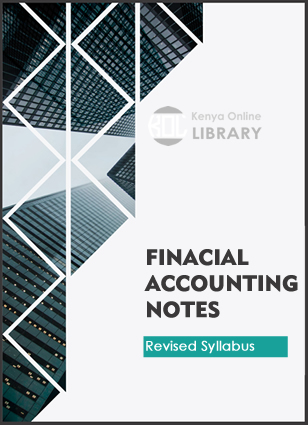
FINANCIAL ACCOUNTING KASNEB NOTES UNIT DESCRIPTION
This CPA Financial Accounting KASNEB Notes is intended to introduce the candidate to the overall purpose of accounting, applicable regulations, the accounting treatment and presentation of basic transactions and preparation and analysis of financial statements.
FINANCIAL ACCOUNTING NOTES LEARNING OUTCOMES
A candidate who passes this paper should be able to:
• Prepare books of original entry and basic ledger accounts under the double entry system
• Prepare basic financial statements of sole traders, partnerships, companies, manufacturing entities and not for profit organisations
• Comply with the regulatory framework in the accounting field
• Analyse financial statements by use of ratios and statement of cash flows
• Demonstrate basic understanding of public sector accounting framework
FINANCIAL ACCOUNTING NOTES CONTENTS
Download FINANCIAL ACCOUNTING CPA NOTES
The Financial Accounting Notes Course Contents are :
Contents
- 1 Introduction to Accounting
- 2 The Accounting Process and Systems
- 3 Regulation and other principles guiding the accounting profession
- 4 Accounting for Assets and Liabilities
- 5 Financial Statements of a sole trader
- 6 Financial Statements of a partnership
- 7 Financial Statements of a company
- 8 Financial Statements of a manufacturing entity
- 9 Statements of a not-for-profit entity
- 10 Correction of errors and preparing financial statements with incomplete records
- 11 Analyzing Financial Statements
- 12 Accounting in the Public Sector
1. Introduction to Accounting
- Nature and Purpose of Accounting
- The objective of Financial Accounting
- The Elements of Financial Statements
- The Accounting Equation
- The Users of Accounting Information
2. The Accounting Process and Systemsg
- The Source documents such as receipts and invoices
- The Books of Prime entry/Original Entry from the journals, cashbooks, Petty cash books and registers
- The Ledger and the concept of double entry
- The Trial Balance
- The Financial Statements
3. Regulation and other principles guiding the accounting profession
- The legal sources of regulation
- The professional sources of regulation (local and international bodies) and ethical requirements
- Accounting Standards
- Qualities of useful financial information
4. Accounting for Assets and Liabilities
- Property, Plant and Equipment (depreciation, acquisition, disposal, exchange, excluding revaluations)
- Intangible Assets
- Financial Assets and Financial Liabilities (Definition, Examples and Classification only)
- Inventory
- Cash in hand and cash at bank (bank reconciliation statements)
- Trade Receivables (Measurement and credit Losses)
- Trade payables
- Accrued Incomes/Expenses and Prepaid Incomes/Expenses
5. Financial Statements of a sole trader
- Statement of Profit or Loss
- Statement of Financial Position
- The Ledger and the concept of double entry
Download FINANCIAL ACCOUNTING CIFA NOTES
6. Financial Statements of a partnership
- he partnership deed/agreement
- The statement of Profit or Loss and appropriation
- Partners’ capital and current accounts
- The statement of financial position
- Accounting treatment and presentation when there is a change in profit/loss sharing ratio, admission/retirement of a partner, dissolution of a partnership
7. Financial Statements of a company
- Important concepts of a company (Ordinary and Preference share capital, issuing new shares by way of full market price, bonus shares and rights issue, Reserves, retained profits and corporation tax)
- Statement of Profit or Loss
- Other comprehensive incomess
- The statement of financial position
- Statement of Cash flows
8. Financial Statements of a manufacturing entity
- Manufacturing Statement of production
- Statement of Profit or Loss
- Statement of Financial Position
9. Statements of a not-for-profit entityy
- Objectives of Not-for-profit organisations
- Statement of Income and Expenditure
- Statement of Financial Position
10. Correction of errors and preparing financial statements with incomplete records
- Types and causes of errors
- Correcting errors in source documents, the books of prime entry, the ledger, the trial balance and financial statements
- Reasons for incomplete information
- Preparation of financial statements from incomplete information
11. Analyzing Financial Statements
- The objective of analysing financial statements
- Analysing financial statements using financial ratios (Liquidity, Profitability, Solvency, Efficiency, Investor/Value and Cash Flow categories)
12. Accounting in the Public Sector
- Features of public sector entities (as compared to private sector)
- Structure of the public sector (National and county governments, State Corporations, Departments and Agencies)
- Regulation and oversight (International Public Sector Accounting Standards Board, Director of Accounting Services, National Treasury, Parliamentary Committees, Accounting Officers at national and county levels)
- Objectives of public sector financial statements and Standards (IPSAS)
- Accounting techniques in public sector such as budgeting, cash, accrual, commitment and fund accounting)
Download FINANCIAL ACCOUNTING CIFA NOTES
